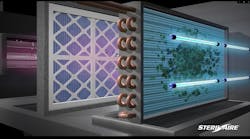Combining DOAS and VRF
I just completed reading your two-part article on DOAS and VRF (“Combining DOAS and VRF, Part 1 of 2,” March 2014, and “Combining DOAS and VRF, Part 2 of 2,” April 2014). Of course, VRF certainly makes sense in a variety of applications—most specifically, where ductwork is not available or jobs where it is not practical to install. However, the author is assuming benefits vs. ducted VAV systems, and in my experience, it doesn’t add up in both first cost and life-cycle costs in North America climates for the following reasons:
- These systems have been sold in the U.S. since 1983. The reason they have not had a lot of success is because they not only cost more, but typically are not more efficient than ducted VAV systems.
- VAV systems sometimes get a bum rap by not including the latest technology available on modern VAV and air-distribution systems—they, too, are available with modulating/variable-speed compressors and fans, along with energy-recovery wheels.
- Duct systems in commercial buildings now are being installed virtually leak-tight using today’s sealing methods, providing multiple points of air distribution in each zone.
- Ducted systems can use outside-air economizers for compressor-free cooling and distribute it throughout a building. VRFs do not have economizer capability. Today’s tight commercial buildings need cooling year-round in the interior. VRF systems must run their compressors on a call for cooling—even at outside-air temperatures below 60°F. In the article, the author mentioned reheat can occur on VAV systems. However, please note that during the winter and transition months, this is compressor-free cooled air! Additionally, many VAV systems use separate perimeter heating systems, thereby eliminating any box reheat.
- Most climates in the U.S. can use economizers six months or more during the year—these climates certainly don’t make sense for VRF, if VAV with economizers can be used.
- VRF systems need DOAS to handle minimum ventilation requirements required by code in the U.S. All DOAS are sized to handle only 100 percent of the ventilation load at design conditions, whereas VAV with enthalpy comparative economizers can handle 100 percent of the total system load with a greater capacity for free cooling (no compressor or pumps necessary). On VAV AHUs, you can have both economizers and ERVs (with bypass)—you can’t have this with a DOAS.
- VRF advocates imply the flexibility of their systems. Ask a contractor how easy it is to move DX fan coils and refrigerant lines in a building. Moving diffusers and VAV boxes is much easier, offering greater tenant flexibility.
- Hundreds of pounds of refrigerant running above a plenum space requires compliance with ANSI/ASHRAE Standard 15, Safety Standard for Refrigeration Systems, in a number of applications.
- As stated in the article, the industry is moving beyond minimum code-compliant systems in order to meet more aggressive targets. If we really look at optimizing the energy-saving controls and features of modern VAV systems, energy studies and real-life building applications show that VAV knocks the socks off these perceived “new VRF” technologies.
I encourage the author to do energy studies comparing modern VAV systems with enthalpy economizers to VRF systems that require year-round compressor operation. He will hear what I continually hear, “Why doesn’t this VRF system beat the energy savings of a VAV?” The answer: Because they simply don’t in most U.S. climates!
Thomas R. Edwards
Ruskin Group
Grandview, Mo.
UV-C for A/C Maintenance
I enjoyed your July 2013 Managing Your Facilities column (“Maintaining A/C-System Performance With UV-C”). With the amount of staph infections we hear of in hospital stays, I feel UV-C lighting should be portable for room use in hospitals and bedrooms at home where someone is ill.
I would appreciate your comments and recommendations.
George Nash
Nash Mechanical Contractors Inc.
Houston, Texas
Author’s response:
The staph infection of greatest concern today is MRSA, or methicillin-resistant Staphylococcus aureus. MRSA is considered mostly a contact-acquired infection. Although the microbe can and has gone airborne, it is unusual.
Washing hands, maintaining room-to-room pressure relationships, and properly cleaning surfaces, garments, bedding, and implements go a long way toward limiting cross-contamination.
Science has not encountered a microbe resistant to the destructive effects of the UV-C energy wavelength, and that includes MRSA. There are four ways to attack infectious microbes with UV-C energy:
- Within air handlers to irradiate cooling coils and drain pans (reservoirs).
- Within air handlers to irradiate circulating air (to inactivate airborne contagions).
- Within upper-air room units to inactivate suspended contagions.
- With portable open-lamp systems that are rolled from room to room to disinfect both air and surfaces.
No. 4 is regaining popularity, although a room must be empty and a unit on for four to six hours, depending on its output. Also, it can be destructive to any organic materials in a room.
As for a portable unit that can be used in a home, this would be a circulating unit (hidden lamp).
Forrest Fencl
UV Resources
Santa Clarita, Calif.
Letters on HPAC Engineering editorial content and issues affecting the HVACR industry are welcome. Please address them to Scott Arnold, executive editor, at [email protected].








